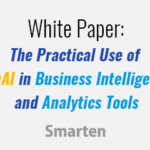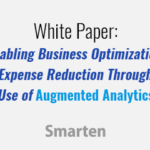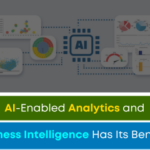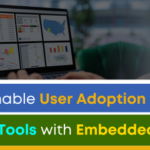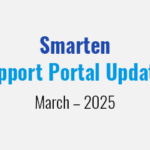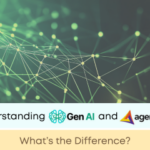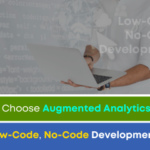This article provides a brief explanation of the Holt-Winters Forecasting model and its application in the business environment.
What is the Holt-Winters Forecasting Algorithm?
The Holt-Winters algorithm is used for forecasting and It is a time-series forecasting method. Time series forecasting methods are used to extract and analyze data and statistics and characterize results to more accurately predict the future based on historical data.
For more information about data trend and pattern analysis techniques, read our article entitled, ‘ What Are Data Trends and Patterns, and How Do They Impact Business Decisions?’
The Holt-Winters forecasting algorithm allows users to smooth a time series and use that data to forecast areas of interest. Exponential smoothing assigns exponentially decreasing weights and values against historical data to decrease the value of the weight for the older data. In other words, more recent historical data is assigned more weight in forecasting than the older results.
There are three types of exponential smoothing methods used in Holt-Winters:
- Single Exponential Smoothing – suitable for forecasting data with no trend or seasonal pattern, where the level of the data may change over time.
- Double Exponential Smoothing – for forecasting data where trends exist.
- Triple Exponential Smoothing – used for forecasting data with trend and/or seasonality.
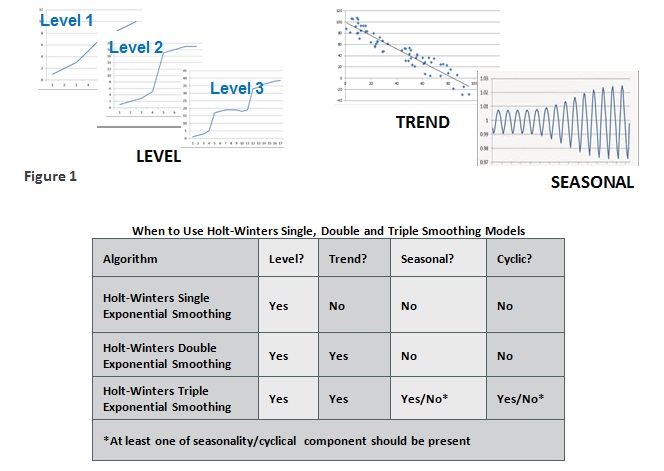
How Can Holt-Winters Forecasting Be Used for Enterprise Analysis?
Time-Series forecasting methods and, in particular, the Holt-Winters forecasting algorithm can be helpful in providing forecasts for planning purposes by using historical data in a meaningful way. Because the results are smoothed, and the user can select the best option for the TYPE of data to be analyzed, the enterprise can avoid assigning too much weight or importance to older data that may no longer be as valid because of changing buying behaviors, market competition or other factors.
Let’s look at a few use cases that represent ideal examples of the various Holt-Winters exponential smoothing methods:
1) Single Exponential Smoothing Use Case
- Business Problem: Forecasting number of viewers by day for a particular game show for next two months.
- Input Data: Last six months daily viewer count data.
- Data Pattern: Data taken as an input exhibit no trend /seasonality.
- Business Benefit: Helps in planning for repeat telecast and for more advertisement (fund raising) if the projected count of viewers is high. Improvement planning can be done for the game show to increase/maintain the level of popularity.
2) Double Exponential Smoothing Use Case
- Business Problem: Insurance claim manager wants to forecast policy sales for next month based on past 12 months data.
- Data Pattern: Input data exhibits level and strong upward trend but no seasonality.
- Business Benefit: If projected claims are lower than expected then proper marketing strategy can be devised to improve sales. Competition policy can be analyzed in terms of what all perks and benefits they provide to customers and existing policy can be modified to increase the market share.
3) Triple Exponential Smoothing Use Case
- Business Problem: A power generator company wants to predict the electricity demand for next two months based on past 2 years’ daily power consumption data.
- Data Pattern: Input data exhibits trend and seasonality.
- Business Benefit: A power generator company can make use of these forecasts for the control and scheduling of power systems or power purchase agreements. It helps in balancing supply and demand.
When users select the appropriate forecasting algorithm for the data they wish to analyze, they can produce and share reports and data that will provide clear direction and decision support. In order to achieve the right results, it is imperative that a user select the right forecasting algorithm, based on the pattern and underlying data. Tools such as Smarten Plug n’ Play predictive analysis provide assisted predictive modeling capabilities. These augmented analytics tools use machine learning to auto-detect and recommend the best algorithm so users do not have to guess at the right selection. Smart Visualization ensures that data and its interpretation are clearly depicted in simple, natural language.
To provide flexible business intelligence and forecasting tools and ensure data democratization among business users, as well as accurate planning methods, an enterprise must select tools that are easy-to-use and easy to implement. The solution must include a full suite of advanced analytics tools to empower business users and create Citizen Data Scientists whose contribution to the organization will be a real asset and a true contributor to business results.
The Smarten approach to augmented analytics and modern business intelligence focuses on the business user and provides tools for Advanced Data Discovery so users can perform early prototyping and test hypotheses without the skills of a data scientist. Smarten Augmented Analytics tools include assisted predictive modeling, smart data visualization, self-serve data preparation, Clickless Analytics with natural language processing (NLP) for search analytics, Auto Insights, Key Influencer Analytics, and SnapShot monitoring and alerts. These tools are designed for business users with average skills and require no specialized knowledge of statistical analysis or support from IT or data scientists. Businesses can advance Citizen Data Scientist initiatives with in-person and online workshops and self-paced eLearning courses designed to introduce users and businesses to the concept, illustrate the benefits and provide introductory training on analytical concepts and the Citizen Data Scientist role.
The Smarten approach to data discovery is designed as an augmented analytics solution to serve business users. Smarten is a representative vendor in multiple Gartner reports including the Gartner Modern BI and Analytics Platform report and the Gartner Magic Quadrant for Business Intelligence and Analytics Platforms Report.



